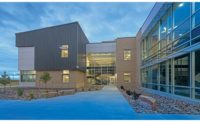Nearly 10 years ago, the leadership of JLG Architects took the first steps on a strategic growth path aimed at transitioning the closely held, generalist design studio that co-founder and president Lonnie Laffen recalls “did everything” into a sustainable organization capable of delivering specialized expertise beyond its original Minnesota-and-Dakotas-centric service area.
With the company marking its 30th anniversary in 2019, the plan appears to be paying off, and in a big way. Last year JLG’s revenue for the Colorado, Wyoming and Dakotas area alone topped $33.2 million, nearly double its 2017 performance. But stellar revenue growth was only one of several factors contributing to JLG’s selection as ENR Mountain States’ Design Firm of the Year for Colorado, Wyoming and the Dakotas.
High-profile projects dot the firm’s portfolio, including the $305-million, 500,000-sq-ft Altru Health System Hospital in Grand Forks, N.D.; the $50-million transformation of a downtown Sioux Falls, S.D., parking garage into a new live-work-play center; and the $150-million Theodore Roosevelt Presidential Library and Museum in Medora, N.D.
JLG also completed a strategic leadership change during 2018, with Laffen turning over the CEO role to Michelle Mongeon Allen, who previously served as the firm’s COO. While continuing as the firm’s president, Laffen can now devote more attention to JLG’s burgeoning hockey-arena design practice.
Allen considers leadership realignment a natural response to JLG’s rise over the past several years. A combination of strategic acquisitions and organic growth has transformed the firm from four offices and only 25 employees into an enterprise with nearly 120 employees in 12 offices in the Dakotas and Minnesota. Office No. 13, in St. Cloud, Minn., opened this year.
Allen adds that scaling to a more market-based growth strategy meant making sure the right management infrastructure was in place. “In 2018 we saw the first evidence of how well that effort was working,” she says.
A key move in JLG’s evolution came in 2014, when the firm became fully employee-owned, a departure, Laffen recalls, from the original plan to limit ownership buy-in to a handful of principals. As a result of the rapid expansion, JLG found itself with “20 baby boomers and 100 millennials,” Laffen says, a size that made an employee stock-ownership plan (ESOP) more feasible and helped settle any concerns about future ownership. The firm had 12 owners (four majority, eight minority) before the ESOP.
Thanks to JLG’s well-established “open-book” culture, Allen adds, “the ESOP was big, but it didn’t mark a 180-degree shift” in its management approach. Retaining its one-firm model, which emphasizes specialty studios instead of geographic profit centers, JLG continues to focus on health care, K-12, higher education and sports facilities, among other projects.
Remaining Client Focused
Yet even with these national ambitions, JLG director of design Jeff Steiner says it’s critical for the firm to remain close to its clients, who want to make a difference in their communities. That includes providing a strong customer service element, as evidenced by the Altru hospital project, which had its own leadership changes as planning and design got underway.
“They needed us to be a strong partner in helping to execute an already complex project,” Steiner says. “We needed to see things through their eyes and provide a higher level of project management to ensure that all design input was incorporated into a clear design concept.”
JLG’s history and approach to design is a natural complement to relatively small clients that likewise harbor big dreams. At Dakota State University in Madison, S.D., for example, the firm designed an advanced research facility. The first of its kind in the Midwest, the facility will support classified government and industry work.
Currently, JLG is collaborating with Dakota State on an athletics master plan to consolidate its sports programs into a single district. The program’s primary components—an events center, indoor practice facility and football field—will share a two-level concourse that will house support spaces for athletics and academic programs and improve the game-day experience for alumni and fans.
Developing the master plan was “a fun process,” with JLG bringing many ideas to the table, according to Stacy Krusemark, Dakota State vice president of business and administration. “The plan is efficient and effective, with no wasted space.”
Krusemark adds that JLG’s community engagement services are playing a key role in fundraising to help turn the master plan concepts into reality.
“Nothing excites potential donors like a great design,” Krusemark says, noting that JLG’s augmented reality component in its design meshes with Dakota State’s role as the state’s designated IT school.
Power Play Into a New Market
Still, to truly make a splash on the national stage, JLG’s leadership felt the firm needed a niche it could call its own.
“We asked ourselves what people would believe a design firm from our region would be good at,” Allen recalls. “The answer was ice hockey arenas. Along with having passionate fans and strong community support wherever it’s played, the sports community is very close. That helped us establish a presence relatively quickly.”
JLG now has 17 hockey projects underway across the country, including Colorado College’s new $30-million Edward J. Robson Arena in Colorado Springs. Along with being the first on-campus home for the school’s hockey teams in 80 years, the 3,000-seat arena will set a benchmark in sports facilities design as a carbon-neutral facility, utilizing a new 10-megawatt solar array and existing on-campus sources for energy.
Chris Coulter, Colorado College director of facilities, credits Laffen and JLG for understanding the hockey program’s history, current and long-term needs and the inherent challenges of competing with the country’s elite hockey schools.
“Lonnie put together a remarkable design team and has stayed involved—something you don’t always see with the principal of an architectural firm,” Coulter says. “He wants to be sure our design meets all our needs, and that it lasts. This is a 25- to 50-year facility.”
Coulter expects Robson Arena to become a lasting landmark in other ways. As part of Colorado Springs’ City for Champions initiative, aimed at boosting sports-related tourism and economic development, the facility will be well positioned to host hockey tournaments involving teams from across the country.
“This is a high-visibility project,” he adds.
Opportunities to Serve
One facet that hasn’t changed with JLG’s growth is its commitment to community service, a tradition that Laffen says goes back to his childhood in a town of 250 people, “where everybody did a lot of things.”
As JLG grew, it attracted others who had grown up in the same culture. “As we opened more offices,” Laffen says, “we wanted to give our people opportunities to continue doing that.”
In addition to JLG’s commitment to AIA’s 1+ program, in which 1% of the firm’s billings are donated to not-for-profit work, the firm supports more than 200 local and regional charities by hosting collegiate video competitions, community cleanups and fundraising events. “Rock the Streets,” a JLG-hosted annual dance party, has become an end-of-summer staple in Grand Forks, Fargo and other communities the firm has served throughout its history.
These and other efforts contributed to JLG’s selection last year as one of the nation’s 50 most admired companies by MSN Money and the lifestyle website BestLife.com. According to BestLife, the designation was drawn from “interviews, local business trade magazines, major outlets like Forbes and Fortune and other statistics.”
Thanks to continued strength in its core service areas, Allen considers JLG well positioned to achieve its broader ambitions. The firm’s sports design studio is just the start. “Becoming better known in that area will help create opportunities for the other specialties,” she says.
Regardless of how JLG’s strategy unfolds, Laffen says the fundamental principles that have guided the firm’s growth to this point won’t change.
“It’s so ingrained in our culture,” he says. “I don’t see how it could ever change.”










Post a comment to this article
Report Abusive Comment